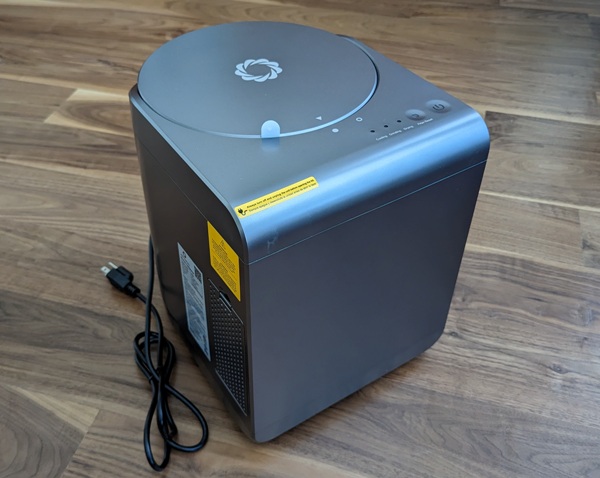
REVIEW – I’ve been thinking about getting an electric kitchen composter for a while now. So when the Airthereal Revive Electric Kitchen Composter came up for review, I was eager to give it a try. The result? It handled all my food scraps well and greatly reduced the volume of the food waste that I had.
What is it?
The Airthereal Revive Electric Kitchen Composter is a small electric kitchen appliance that heats, dries, and chops up your food scraps so that you can add the material to your soil.
Note about the compost from electric composters: The word “compost” implies that the food scraps have decomposed. Many consumer electric kitchen composters like the Airthereal Revive Electric Kitchen Composter do NOT decompose food scraps (“Electric Composters – An Eco Win or Unnecessary Appliance?” from the Garden Myths website). They simply reduce the food waste volume by heating the scraps to about 160 degrees F to dry them out, then they chop them up, and lastly, they cool scraps (“What Is an Electric Composter and How Does It Work?” from the Family Handyman website). The heating and drying process kills most of the bacteria when compared to traditional compost (“What Is an Electric Composter and How Does It Work?” from the Family Handyman website).
Some electric composters have the user add microbes to decompose the scraps; however, the Airthereal Revive Electric Kitchen Composter doesn’t use this additive. Therefore, soil nutrients such as potassium, nitrogen, and phosphorus contained in dried food scraps from composters like the Airthereal composter are still unusable to plants until they are broken down by microorganisms and decomposing organisms (“Electric Composters – An Eco Win or Unnecessary Appliance?” under the section “Do Electronic Composters Produce Fertilizer?” from the Garden Myths website).
Thus, when you add the resulting dried food material to your soil, it is advisable to delay incorporating it into your soil until it has time to decompose so that decomposition won’t hinder seed germination (“Electric Composters – An Eco Win or Unnecessary Appliance?” under the section “Do Electronic Composters Produce Fertilizer?” from the Garden Myths website). I took this information to mean that using the dried scraps as mulch would be okay, especially for established plants like those in my garden beds. When you use the dried scraps as a top dressing or mulch, as you water the plants, the dried material will decompose slowly over time.
The benefit of using an electric composter is that it keeps large amounts of food waste out of landfills which thereby reduces the methane gas created from anaerobic decomposition. This kind of decomposition occurs when organic waste is covered up in landfills and oxygen is limited (“Composting 101” under the section “Cuts Methane Emissions From Landfills” from the Natural Resources Defense Council website). Anaerobic microorganisms do the work but end up producing methane gas and carbon dioxide which are greenhouse gases (“Composting 101” under the section “Cuts Methane Emissions From Landfills” from the Natural Resources Defense Council website).
What’s in the box?
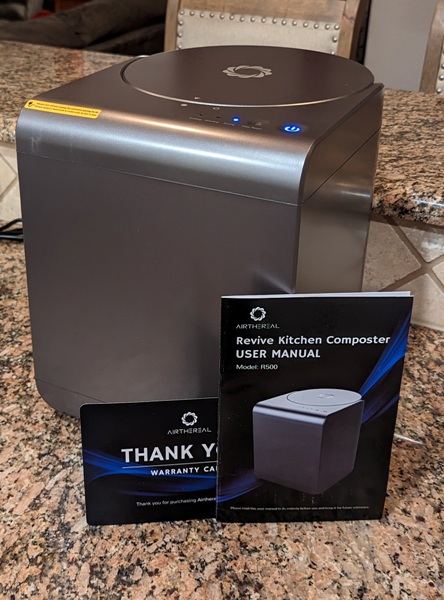
- Revive Electric Kitchen Composter
- 2 biodegradable carbon filters
- User manual
- Thank you/warranty card
Hardware specs
- Model R500
- Processing Cycles: Drying, Grinding, Cooling
- Rated Voltage: 120V, 60HZ
- Rated Power: 500W max. (Grinding & Drying)
- Capacity: 5.4pint (2.5L)
- Processing Time: 2-7 hours
- Waste Volume Reduction: 80-90%
- Filter: Activated Carbon
- Noise: <60dB
- Item Dimensions: 12.5″ L x 10.0″ W x 12.5″ H (318 x 255 x 318 mm)
- Item Weight: 16.8 lbs (7.6 kg)
Design and features

The Airthereal Revive Kitchen Composter’s exterior is made of matte gray plastic which keeps the machine cooler when running than if it were made of metal. It measures 12.5″ L x 10.0″ W x 12.5″ H (318 x 255 x 318 mm) and thus doesn’t take up much countertop space.
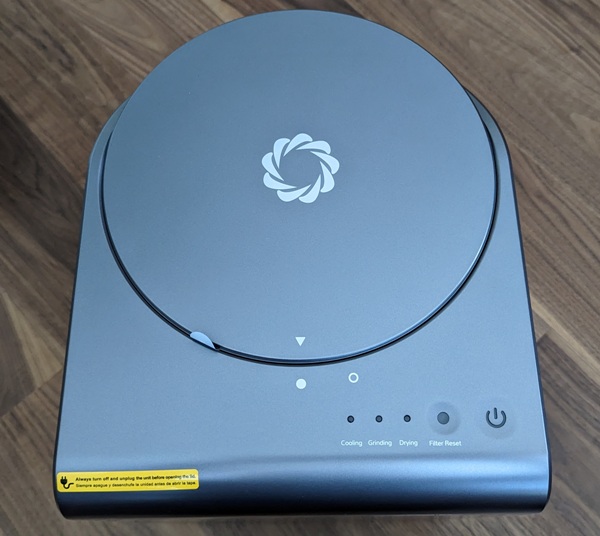
The lid of the composter can be removed by rotating it counterclockwise so that the arrow on the lid aligns with the open circle on the top of the composter. To lock the lid in place, you rotate the lid clockwise until the arrow aligns with the solid circle on the top of the composter. Once the lid is locked, the composter beeps (when plugged in).
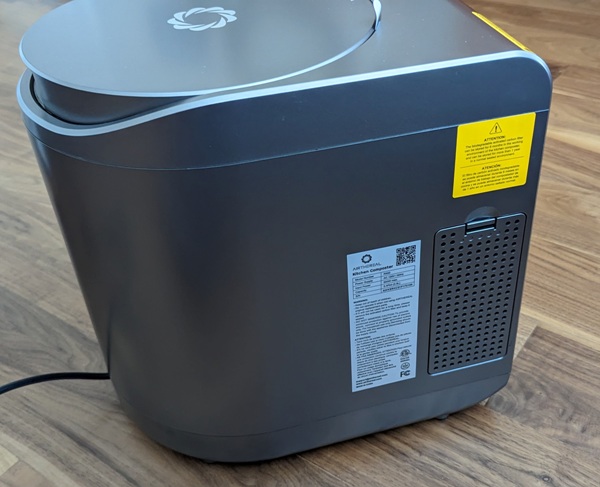
The side of the composter contains the cover for the carbon filter. The filter absorbs odors from your food scraps.
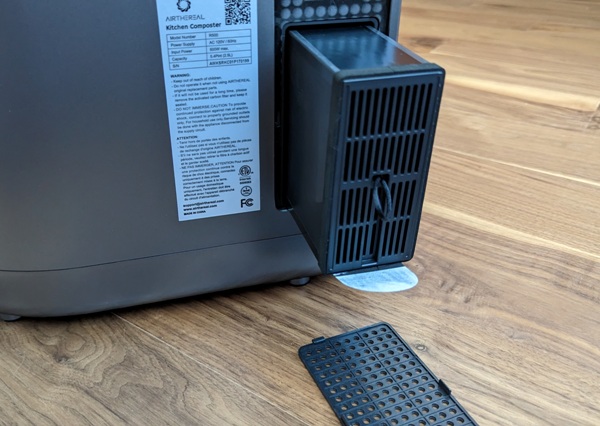
The carbon filter box has a loop that makes extracting it easy when you need to replace it. Before using the composter, you must remove the adhesive tape surrounding the filter. The filter can be used for six months before needing to be replaced. A sealed unused filter is good for one year.
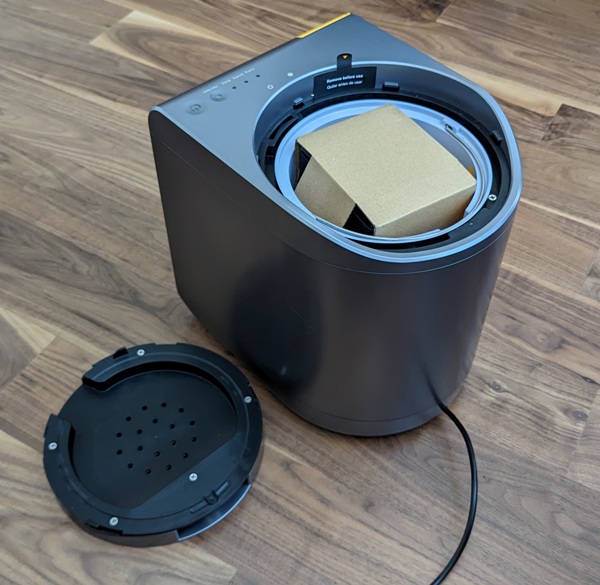
When you receive the Revive Kitchen Composter, you will find the second carbon filter that comes with it inside the composter.
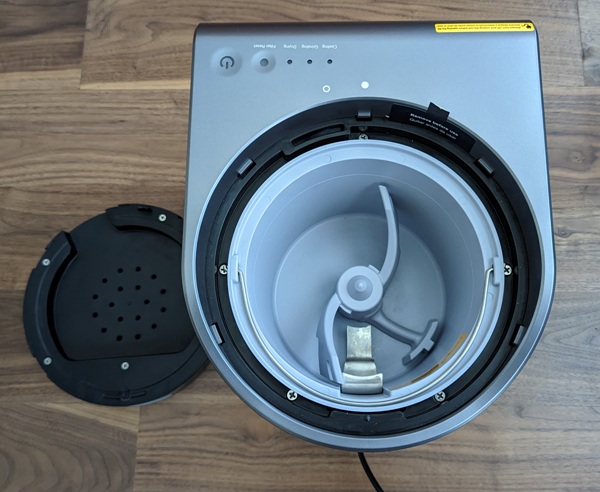
Inside the composter is the removable bucket. This bucket is made of metal and has three cast aluminum blades to chop up food.
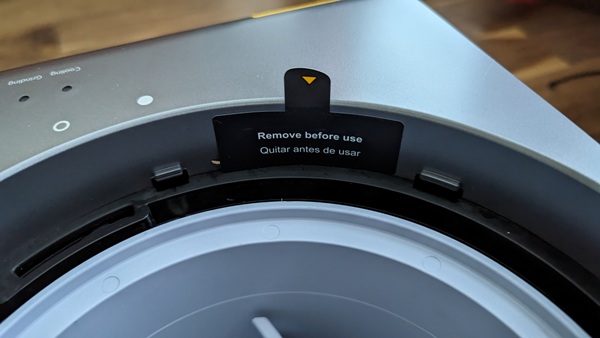
Before you use the composter, you must remove the adhesive tape inside of it.
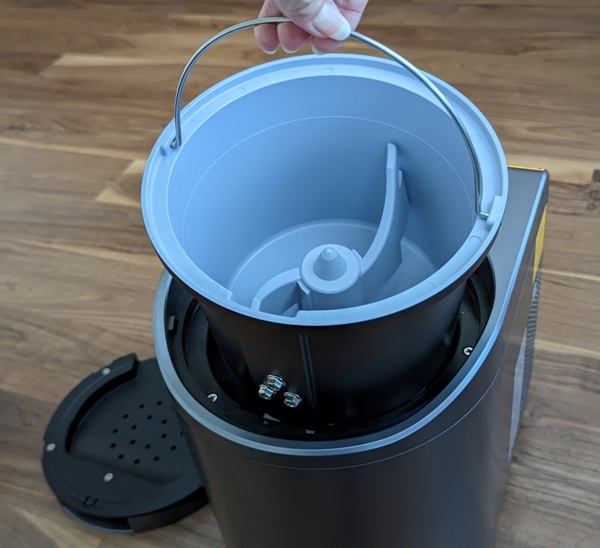
The bucket is easily removed by simply lifting it by its handle. It feels heavy-duty. The bucket holds 2.5L of food scraps and has a nice scratch-resistant nonstick coating.
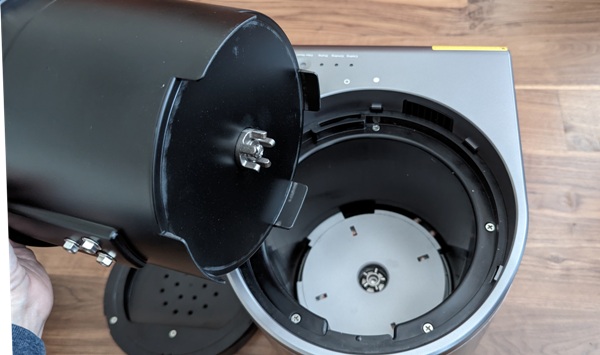
The bottom of the bucket contains five metal prongs that fit into the bottom of the composter. When seated properly into the composter, these allow that motor to rotate the blades inside the bucket.
Performance
Background research on landfill decomposition and landfill gases from U.S. government websites
The following table describes the four phases of the decomposition of waste in a landfill. There are different types of bacteria present in each phase that break down the waste according to the conditions present.
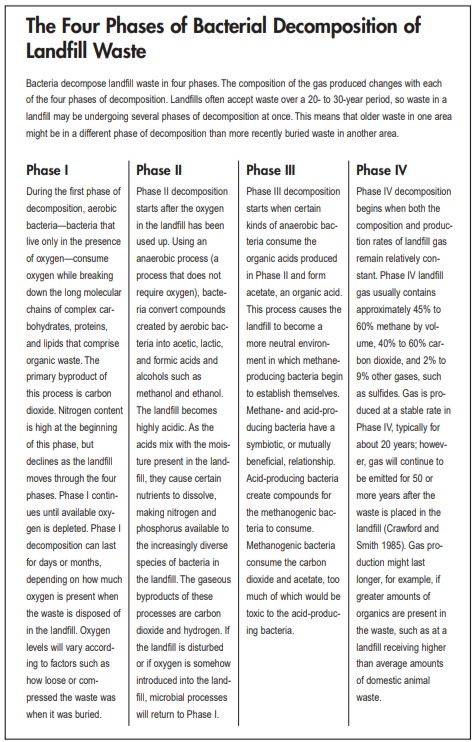
From Chapter 2: Landfill Gas Basics. In Landfill Gas Primer – An Overview for Environmental Health Professionals. Figure 2-1, pp. 5-6. https://www.atsdr.cdc.gov/HAC/landfill/PDFs/Landfill_2001_ch2mod.pdf (PDF)(12 pp, 2MB)
The following figure illustrates the types and amounts of landfill gases that are produced during each of the phases of waste decomposition.
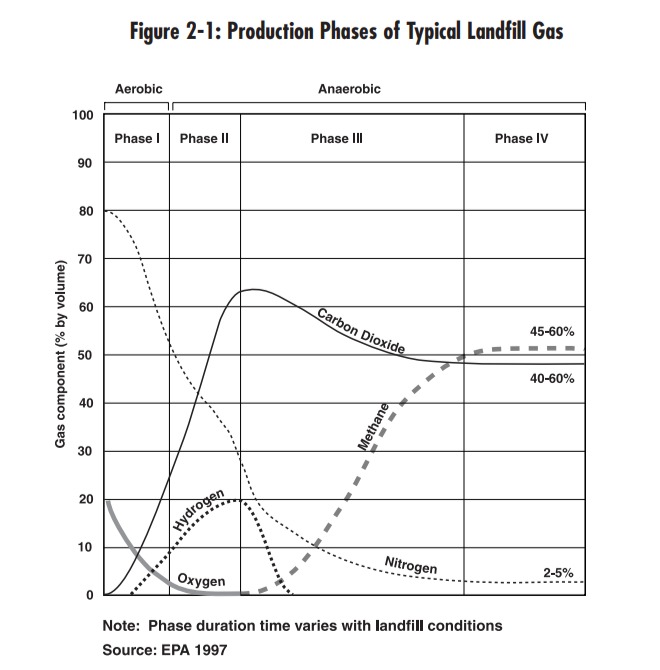
From Chapter 2: Landfill Gas Basics. In Landfill Gas Primer – An Overview for Environmental Health Professionals. Figure 2-1, pp. 5-6. https://www.atsdr.cdc.gov/HAC/landfill/PDFs/Landfill_2001_ch2mod.pdf (PDF)(12 pp, 2MB)
The following table describes the major gasses present in landfills.
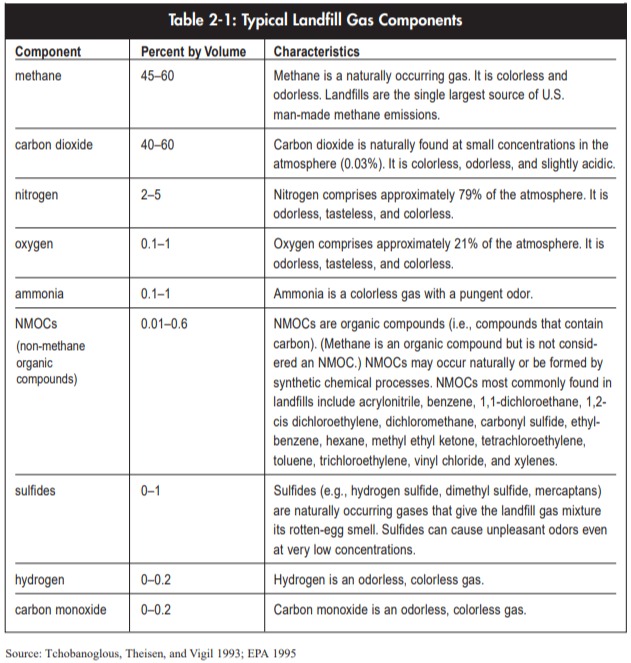
EPA. 1995. U.S. Environmental Protection Agency. Compilation of Air Pollutant Emissions Factors, AP-42, FifthEditionn, Volume 1: Stationary Point and Area Sources. January 1995. http://www.epa.gov/ttn/chief/ap42/ch02/ Section 2.4—Municipal Solid Waste Landfills.
Tchobanoglous G, Theisen H, and Vigil S. 1993. Integrated Solid Waste Management, Engineering Principles, and Management Issues. New York: McGraw-Hill, Inc. pp. 381-417.
The above information illustrates why I want to try to decrease the amount of organic material that I send to the landfill. While I’ve thought about trying traditional composting, I’ve decided against it for a few reasons. Traditional composting requires a bit of work to get the correct ratio of green and brown materials to compost most effectively, and it requires time to correctly aerate. Additionally, I live in a densely populated subdivision so if I do it improperly, it can attract flies, rodents, and other critters. Not great for me or my neighbors. For these reasons, I’ve been wanting to try an electric kitchen composter like the Airthereal Revive Electric Kitchen Composter as an option to reduce the amount of waste that goes to a landfill.
Results from using the Airthereal Revive Electric Kitchen Composter
Below is a list of things you can and cannot put in the Revive Electric Kitchen Composter:
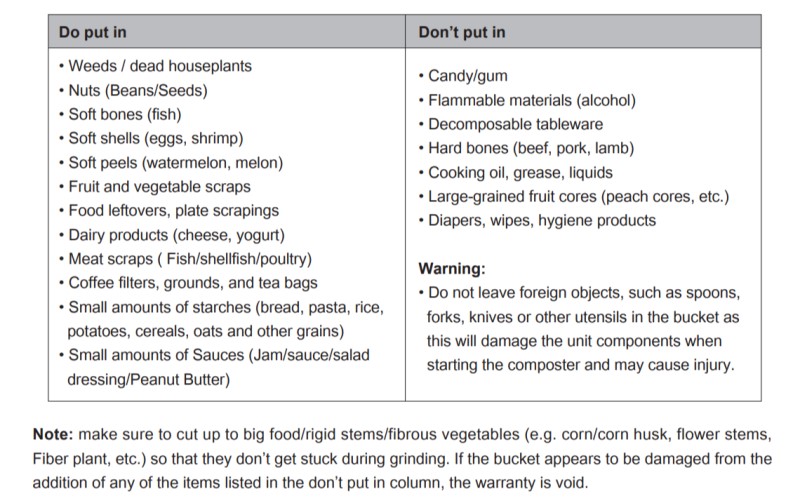
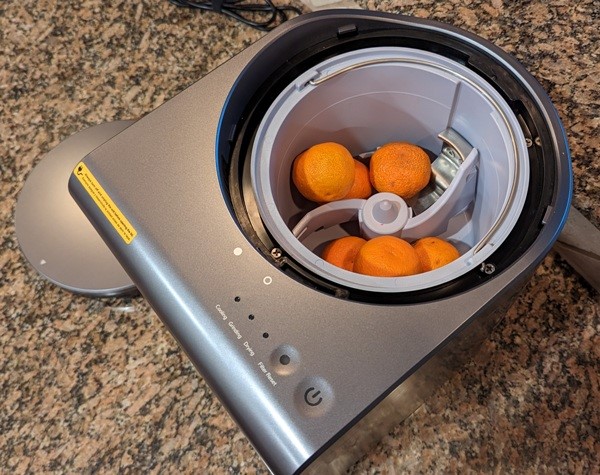
I first tested the composter by throwing in some very old and shriveled Cuties (mandarin oranges) into the bucket. As you can see, I didn’t cut them up. I put the lid on and then hit the power button located on the top of the machine.
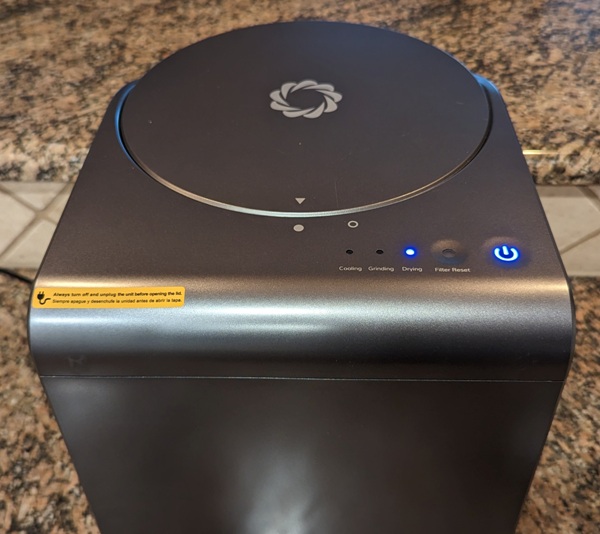
The first cycle that the composter goes through is the heating and drying cycle. Then it goes through the grinding cycle and last the cooling cycle.
The composter is fairly quiet (<60dB) – about as quiet as my Bosch dishwasher.
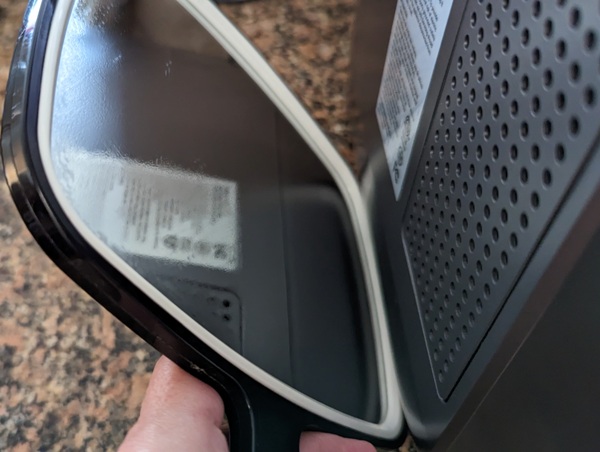
I noticed that when running, the composter emits warm humid air as shown in the photo above.
The was only a faint aroma of oranges as the composter processed this batch of old oranges.
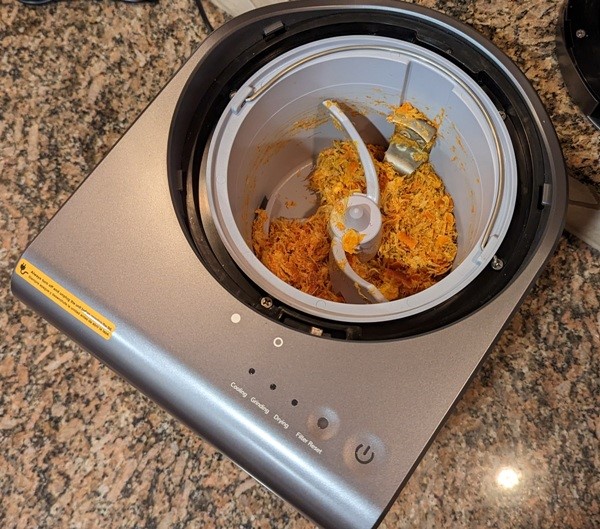
When the processing was complete about 2 hours later, this is what the dried oranges looked like.
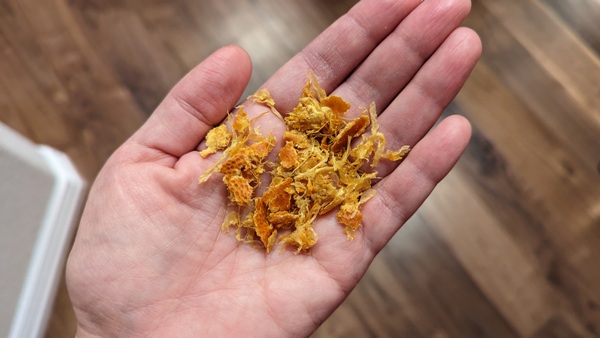
Above is a photo that shows how large the pieces of the dried material were.
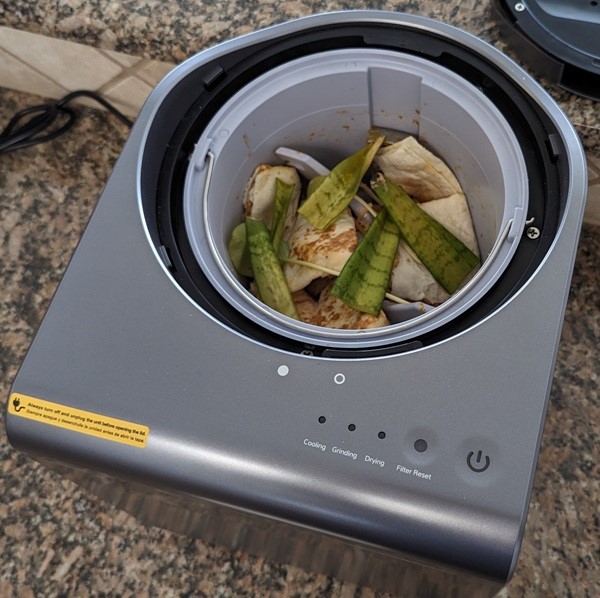
Next, I used the composter to process some mozzarella cheese sticks, some old chicken-and-cheese quesadillas, and some old snake plant leaves from my house plants.
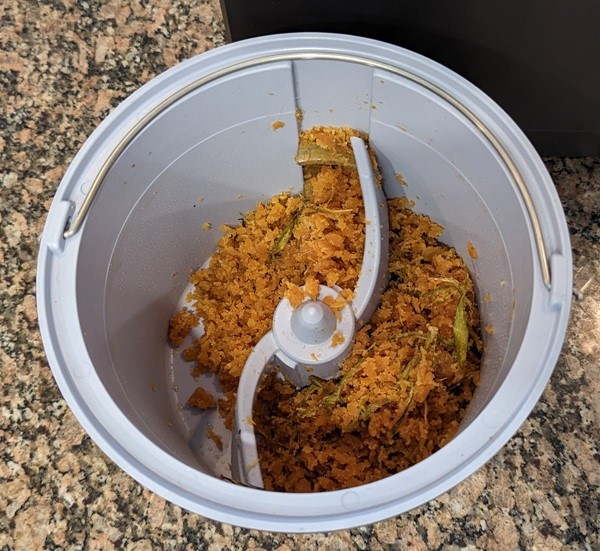
About 2.5 hours later, I had the above results. Because this batch was mainly cheese, the result was very oily.
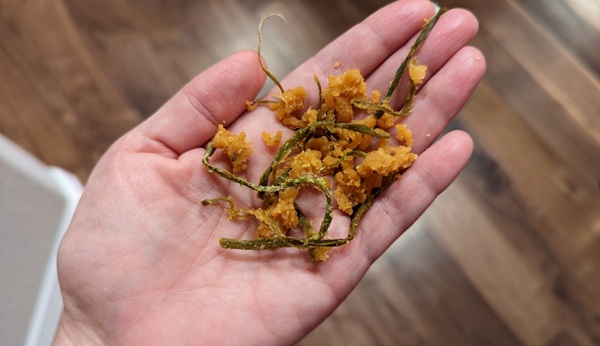
These were the size of the chunks that were left after processing. I know that cheese is not something that is not typically composted because, like meat and other animal products, it can attract pests like flies and rodents. Thus, I didn’t put this in any indoor or outdoor soil.
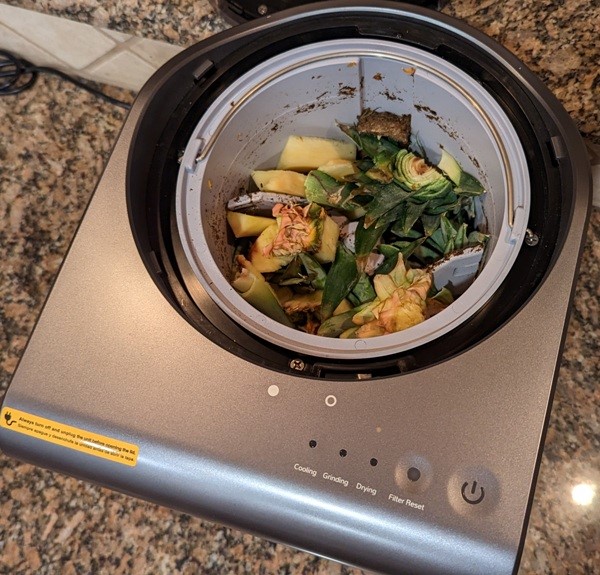
Then, I used the composter to process pineapple scraps from a whole pineapple that I cut up. I diced the scraps first before placing them into the bucket (even the pineapple top).
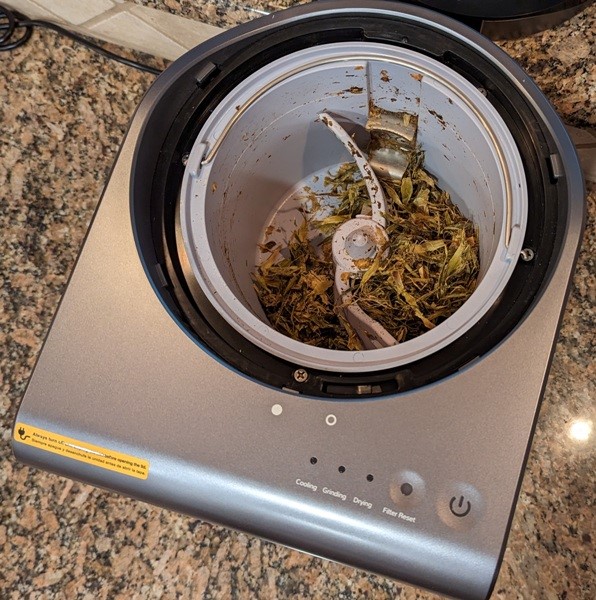
The above photo shows the result. The pineapple scraps took the longest to process of all the food waste I tried in the composter. It took about 3.5 hours to finish.
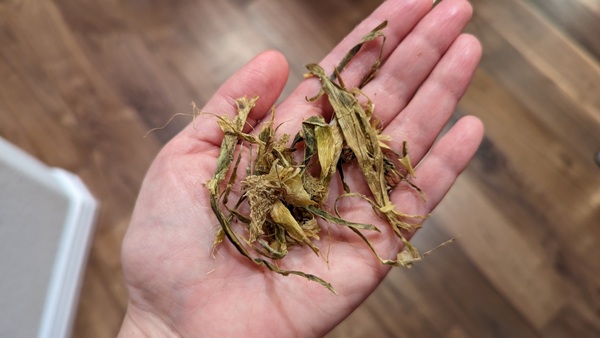
The pieces of dried and chopped pineapple were fairly large. I wish that they were smaller, but it’s not too bad.
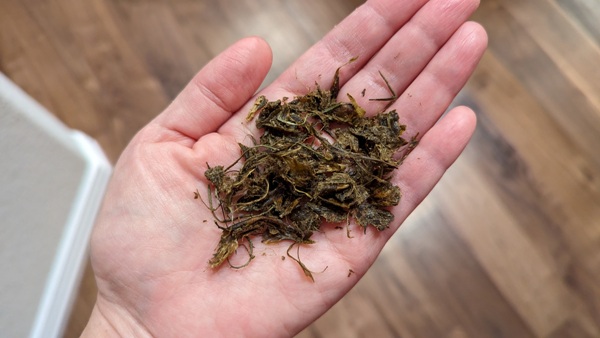
The best result I had from the Airthereal Revive Electric Kitchen Composter was when I mixed banana peels, orange peels, dead pothos plant leaves, and Spanish moss. These dried food scraps looked the most like “soil” from all my trials using this composter.
I didn’t have any issues with the composter. It dried and chopped up my food scraps quietly and quickly. I guess if I had anything to pick on, it would be the large size of the ground-up food scraps. I ended up throwing the larger chunks of dried food into a food processor to create a finer consistency. I probably won’t always do that though.
Since the dried food scraps have not decomposed yet and thus won’t provide much in the way of nutrients to my plants until they do, I used my dried scraps as mulch for my front garden beds rather than mixing them into the soil. I like the fact that the composter greatly reduces the volume of my food waste, allows me to use it in my garden bed, and keeps it out of my trash.
The Airthereal Revive Electric Kitchen Composter uses about 1.6 KWh per cycle (or per use). Thus, Airthereal estimates that at $0.13 per KWh, it would cost $0.21 per cycle. So if you used it 10 times per month, it would cost an estimated $25 per year which makes it fairly economical.
What I like
- It’s a relatively small kitchen appliance and doesn’t take up much countertop space
- It greatly reduces the volume of my food waste by drying, grinding, and cooling the scraps
- It’s quick and dried most of my food waste in about 2-4 hours
- It’s fairly quiet and emits minimal odors
What I’d change
- It’s a little expensive
Final thoughts
I truly enjoyed using the Airthereal Revive Electric Kitchen Composter. Although it doesn’t decompose food waste as traditional composting does, it dried and chopped up my food scraps like banana peels, orange peels, house-plant leaves, and even the fibrous pineapple scraps quietly and quickly.
I like the fact that I can keep organic waste out of my trash and that the composter greatly reduces the volume of that waste and allows me to use it as mulch in my garden bed.
It is a little expensive, but I really like having it. The composter’s bucket is also a little small (2.5L), but our family works hard to use our food efficiently so that there is minimal waste; thus this size is perfect for our needs.
If you don’t mind the cost and you don’t have the space or time for traditional composting, then the Airthereal Revive Electric Kitchen Composter is a good option to help you deal with your food waste.
Update 9/25/24
I use this composter ALL the time and I love it. It reduces the volume of my food waste to a fraction of the original amount and keeps it out of the landfill. It doesn’t actually decompose the scraps but rather heats, grinds, and dries them. Even though it’s not officially compost, I still use it on my lawn but with the understanding that it will take a lot more time for the dried scraps to decompose (you need to mix it in with your soil to prevent mold growth). Revive recently came out with an additive that helps accelerate the decomposition of your food waste so you can use it as compost in your garden after just a few weeks. Maybe I’ll give that a try in the future. The only negative thing about the Airthereal electric composter is that the bowl’s non-stick coating is flaking off.
Price: $349.99
Where to buy: Airthereal and Amazon
Source: The sample of this product was provided by Airthereal.



Gadgeteer Comment Policy - Please read before commenting
Interesting – that’s a process I might have tried if I wasn’t able to pay a company $100/yr to pick up my weekly bin of compost. But for that price I’d be tempted to first try using an oven and a blender to DIY it – or maybe that electric food dryer sitting in my basement 🙂
Betty – I thought the same thing that you did about using an oven and a food processor or blender. But this gets it done without me having to turn on my full-sized oven and then getting out my food processor, so I prefer using this electric composter.
From your images it appears you ran it doing small batches to test a variety of materials. Are small batches required or can you run it with a full bucket? Any idea how much longer that might take?
Suzanne – When processing the pineapple scraps, it actually required me to run the composter twice because there were so many scraps. It is only a 2.5L bucket and thus is a little too small for rinds from a full watermelon or pineapple.
I imagine the amount of time required to process a full bucket depends on what you are composting. Since it first dries the scraps, it probably takes additional time to dry out high-water content material like watermelon rinds. Then it has to chop up the scraps which may take more time with tough rinds like pineapple. When processing one bucketful of pineapple, it took about 3.5 to 4 hours. This was the longest processing time that I have experienced when using this electric kitchen composter.
I hope this helps! 😀
Very helpful as was the review itself, thanks.